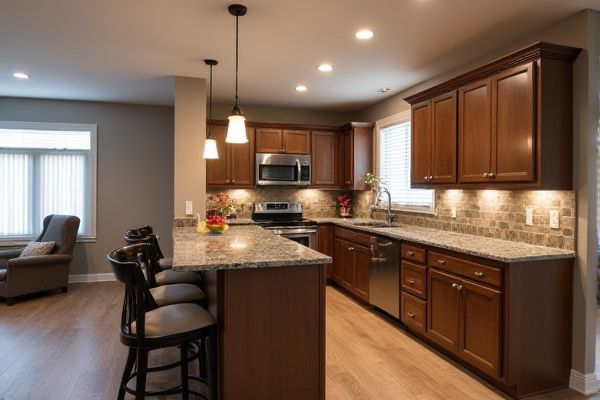
A basement kitchenette offers a full cooking area with appliances such as a stove, refrigerator, and sink, allowing you to prepare meals, while a wet bar primarily provides a sink and counter space designed for mixing drinks and light refreshments. Discover the key differences and decide which setup best suits your basement needs by reading the rest of the article.
Table of Comparison
| Feature | Basement Kitchenette | Wet Bar |
|---|---|---|
| Purpose | Full light cooking and food prep | Mixing drinks and light beverage service |
| Appliances | Includes stove, refrigerator, sink, microwave | Includes sink, mini-fridge, ice maker |
| Space Requirement | Larger footprint, designated cooking area | Compact, fits into small corner spaces |
| Installation Cost | Higher due to plumbing and electrical needs | Lower, simpler plumbing |
| Usage | Meal preparation, snacks, and hosting | Entertaining, casual drink service |
| Ventilation | Requires good ventilation for cooking fumes | Minimal ventilation needed |
Understanding Basement Kitchenettes
Basement kitchenettes offer compact cooking solutions designed with essential appliances like a mini-fridge, microwave, and sink, enabling food preparation and basic meals without the need for a full kitchen. Unlike wet bars, which primarily focus on beverage service with sinks and counter space for drinks, basement kitchenettes provide greater functionality for cooking and storage. This makes basement kitchenettes ideal for guest suites, rental units, or entertaining spaces where meal preparation is necessary alongside drink service.
What Is a Wet Bar?
A wet bar features a built-in sink with running water, designed for mixing and serving drinks efficiently, making it ideal for entertaining guests. Unlike a basement kitchenette, which includes full appliances for cooking and food preparation, a wet bar is more compact and focused solely on beverage service. Your choice depends on whether you prioritize drink convenience or a broader kitchen functionality in your basement space.
Key Differences Between a Kitchenette and a Wet Bar
A basement kitchenette features essential appliances such as a microwave, mini-fridge, and sink, designed for light meal preparation and increased functionality, whereas a wet bar primarily includes a small sink and counter space tailored for mixing drinks and serving beverages. Kitchenettes maximize utility with storage cabinets and sometimes a cooktop, supporting extended food service, while wet bars emphasize style and social interaction with specialized racks for glassware and liquor bottles. The spatial layout of a kitchenette is generally larger and more appliance-centric, contrasting with the compact, streamlined design of a wet bar optimized for entertaining.
Space Requirements and Layout Considerations
Basement kitchenettes demand more space due to essential appliances like mini refrigerators, sinks, and sometimes microwaves, requiring a well-planned layout for efficient workflow. Wet bars have smaller footprints, typically featuring a sink, countertop, and storage for glassware, making them suitable for tighter areas. Your choice depends on available space and functional needs, with kitchenettes prioritizing meal prep and wet bars emphasizing entertaining.
Essential Appliances and Features
A basement kitchenette typically includes essential appliances such as a compact refrigerator, microwave, sink, and a small cooktop or oven, enabling full meal preparation and cooking capabilities. A wet bar is centered around beverage service, featuring a sink, wine or beverage cooler, and storage for glassware and mixers, focusing on drink preparation rather than cooking. Your choice depends on whether you need a functional cooking area or a dedicated space for entertaining guests with drinks.
Plumbing and Electrical Needs
A basement kitchenette requires more extensive plumbing with connections for a sink, dishwasher, and possibly a refrigerator with water lines, demanding a robust electrical system to support cooking appliances like microwaves, mini-fridges, and lighting. In contrast, a wet bar typically involves simpler plumbing limited to a small sink and drainage, paired with lower electrical requirements primarily for under-counter refrigeration and ambient lighting. Understanding these differences is crucial for accurate budgeting and compliance with local building codes during basement renovations.
Cost Comparison: Kitchenette vs Wet Bar
A basement kitchenette typically involves higher costs due to the need for appliances such as a refrigerator, sink, stove, and additional cabinetry, which can range from $5,000 to $15,000 depending on the size and quality. In contrast, a wet bar usually requires a smaller investment, averaging between $1,500 and $5,000, since it primarily includes a sink, countertop, and minimal storage. The choice between a basement kitchenette and a wet bar hinges on budget constraints, functionality requirements, and the extent of plumbing and electrical work involved.
Design Ideas and Popular Styles
Basement kitchenette designs often incorporate compact appliances, cabinetry, and countertops optimized for functionality, with popular styles including modern minimalist, rustic farmhouse, and industrial chic. Wet bar designs focus on sleek surfaces, integrated sinks, and stylish shelving, frequently embracing mid-century modern, contemporary, and vintage aesthetics. Both spaces benefit from creative lighting solutions, durable materials, and customized storage to maximize usability and enhance the basement's overall ambiance.
Best Uses for Each Option
A basement kitchenette is ideal for those seeking a fully functional cooking space with a sink, refrigerator, and microwave, perfect for preparing meals or entertaining guests during extended gatherings. A wet bar suits social settings where mixing drinks and serving beverages efficiently is the priority, often featuring a sink and storage for glassware and liquor. Your choice depends on whether you prefer meal preparation capabilities or a dedicated area for cocktail service in your basement.
Choosing the Right Option for Your Basement
Selecting between a basement kitchenette and a wet bar depends on intended use and space availability; a kitchenette offers food preparation capabilities with appliances like a mini-fridge, microwave, and sink, supporting casual meals and entertaining. Wet bars focus on beverage service with features such as built-in wine racks, a compact sink, and cocktail preparation areas, ideal for social gatherings and enhancing entertainment value. Consider lifestyle needs, budget, and desired functionality to determine whether a full kitchenette or a streamlined wet bar best complements your basement design.
 homyna.com
homyna.com